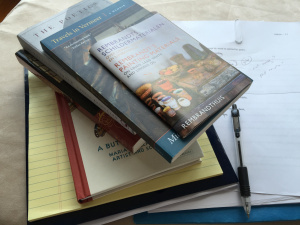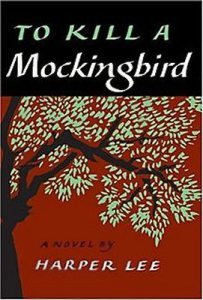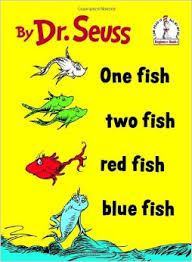The Art of Revision, and Learning from Harper Lee and Dr. Seuss
These days some students learn about revision in third grade, which is fine as long as it’s presented as the creative fun it can be. I grew up in an age of penmanship classes, being asked to check for spelling, but never to revise. I moved on to crossing out sentences or paragraphs as I completed high school papers, but didn’t really revise until college, when I was writing stories of my own that began as many fragments of scenes. I bought a blue typewriter at a garage sale, and learned to white out words or type over paper slips that were chalky on one side and meant to cover up errant letters. The first word processor my husband and I bought was a marvel, even if its printer sounded like a truck. It opened me to more chances for revision, which I would have resisted if it meant retyping entire pages or chapters. I might never have learned that if you’re only looking at what’s already on the paper, you’re doing revision wrong.
I’m currently revising a collection of narrative verse about girls and science called Finding Wonders. There were lots of drafts before it landed on my editor’s desk, including some in which members of my writing group wrote “Huh?” beside some lines. I cleaned up most of those lines, but a few got through, and my editor wrote things like: “Possible to make your meaning clearer?” The courtesy makes me smile, though I’m also fine with my writing group’s directness: we’ve built trust over twenty-five years. My editor thought the pacing of the first section was a bit slow, and suggested taking out one poem and merging two. But “slow” is not what I want to hear about a beginning, though I’ll never be speedy. So I’ve torn apart the first fifteen pages, to tighten and add small walls my character must bump into or vault. I’ve written some good new lines.
Revision is a major part of my process now, though I wish it had a more glamorous name. I like the “vision” within the word, but that “re,” drags the concept of “again” in a way it’s hard not to see as boring. Of course we’re not exactly beginning here, but there’s an element of its thrill, anxiety, and muscle. There can still be surprises. Revision is sort of like trying on clothes for a big occasion, though maybe you don’t know just what will happen. It’s useless to consider scanning the closet or even laying out the clothes. You must try them all on and see how one choice affects the next. Everything gets pulled out of the closet. We can’t think about details or accessories until we have down the general look.
We also can’t think much about structure and pacing in the abstract. It’s an experience. The time to tidy will come, but you’re not really ready until clothes are piled around your ankles. Then at last it’s time to attend to details. Coco Chanel advised women pulling together outfits to take off one thing before they left their houses, and usually we can find some words to snip.
Revising is not just taking away, but includes making a bigger mess, circling back, cutting and adding. Every time I add to a character, even if I scrape off most of what I layered on, I know her better. Our friendship deepens. I move things on and off a character’s table, and also break some open, turn them around. It’s good to take time for things to reveal themselves as possible metaphors. Just because we made this draft doesn’t mean it doesn’t hold some mystery. We should treat that with tender respect.
Sometimes revising looks a lot like research. I find a few new images and information, and replace with some of the old.
Most writers know this sort of everything-out-of-the-closet revision, turning everything inside out. Recent reviews suggest that “newly discovered” work of Harper Lee and Dr. Seuss seem likely to have been drafts of what would become classics that were set aside. It does seem likely the authors didn’t entirely forget or lose these manuscripts, but used them as maps toward something better. In a New York Times Op-Ed column, Joe Nocera suggests Go Set a Watchman could be an earlier draft of To Kill a Mockingbird, pulled out to make money that the author, now ill and in a nursing home, isn’t asking for. He calls this “one of the epic money grabs in the modern history of American publishing.” For Harper Lee’s beloved classic, working alone and with editor, Tay Hohoff, she may have turned some autobiographical details into the more universal truths of fiction, letting characters take on lives of their own. Joe Nocera quotes Harper Lee from one of her last interviews, speaking of the need to love language, to sit down and work “a good idea into a gem of an idea.” Maybe there’s more to this recently published novel, but it sounds like it doesn’t offer an Atticus or Scout I want to know, or the exquisite sentences in To Kill a Mockingbird.
Another recently found book was featured a few days ago on the cover of the Sunday Book Review. Maria Russo writes about What Pet Should I Get, admiring some lines, but notes its theme of two children surveying a variety of pets and trying to make up their minds is less compelling than other works of Dr. Seuss. She sees this book with the same sibling protagonists as somewhat similar to, but lesser than, One Fish Two Fish Red Fish Blue Fish, “a kind of warm-up for the more freewheeling and imaginatively rich — the slightly more classically Seussian — book.” The backstory to this isn’t as creepy or seemingly lawyer-ridden as that of Harper Lee’s just-published book, and I don’t think readers are as likely to feel betrayed as those who’ve been waiting and hoping for decades for one more book from Harper Lee. The finding of this picture book seems more about going through boxes and pulling up something that perhaps isn’t fabulous, but will do. Comparing the two as Maria Russo does shows another way that revision may be taking the plot and adding a layer, with the author finding and claiming his own truth by deepening his dedication to imagination and whimsy.
Dr. Seuss was famous for revision. He sometimes said it took him nine months, and sometimes eighteen, to write the 236 words of The Cat and the Hat. The variation in months may be due to myth-making, or it may be that few of us count our drafts or can measure the time we spend, as we’re not sitting at a desk for eight hours five days a week. Time gets blurry. But we know the words that can be read fast didn’t come quickly.
Publishers are supposed to be gatekeepers, choosing what’s worthy; at least they tell that to those of us who choose forms of self or partnership publishing. It’s one thing to publish junky books for those who want light summer reading, but to publish less than the best of brilliant writers may lose readers who should be cultivated with trust. Everyone needs to make money, but what matters most is to offer readers books that come from long spells of writing, working with good editors, then taking another look. Every day, every hour, writers might remind ourselves that we may like a page, but that doesn’t mean we shouldn’t throw it away. Something may be good, but there could be a way to make it better.








